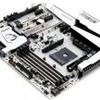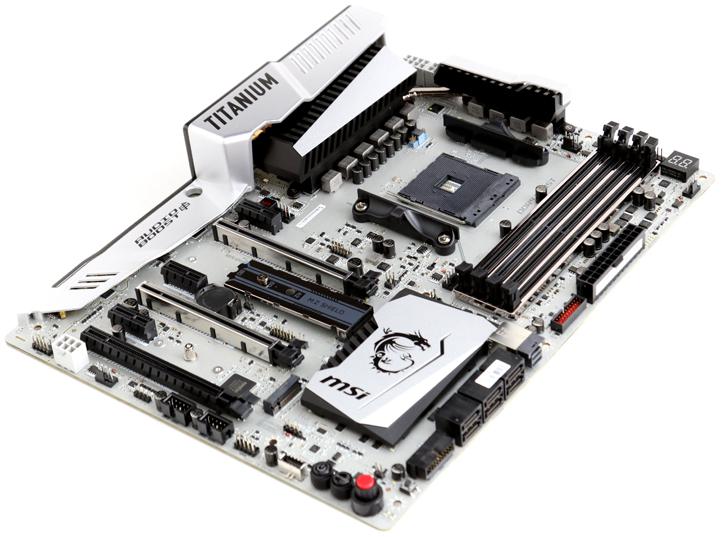Conclusion
The Final Words
In the year 2017 motherboards are not 'just' about performance and features anymore. Aesthetics have become such a massive ingredient of the recipe that is to become your PC. The MSI X370 XPower Gaming Titanium surely is one of the nicest motherboards available. Performance is at roughly the same level as the competition as well, the firmware we feel is very user-friendly. Then again, our memory should have been XMP supported but the board refused to boot, hence we had to insert timings, frequency and voltage manually. No biggy for the regular PC aficionado and DiY kind of guy, but not something we had expected with that cool new A-XMP feature. The Ryzen launch has been a bit of a mixed bag. The platform and processors have the potential to offer great value for money. It performs great, fantastic even in any application. Yet we cannot look away from the fact that game performance in the enthusiast range remains somewhat limited. Enthusiast cards and multi-GPU combinations can run into a CPU bound situation at lower resolutions. These processors still offer plenty of performance if you game at 2560x1440 or higher, or stick to a mid-range graphics card.
The Bad stuff
The MSI X370 XPower Gaming Titanium is one of the more beautiful looking board currently available. That doesn't mean it's the best though as a lot of this board feels a bit rushes maybe? Next to that we miss out features as well. I might be critical here, but this is a 300 euro/usd costing board so you may set your expectations high. When you compare it to the Z270 counterpart for example, several features have been stripped away. Where is the OC dashboard? Why isn't there even a second Ethernet jack? Where is AC WIFI? Then the X370 XPower Gaming Titanium has a number of nags as well. The new A-XMP feature that should help you configure your memory for you did not kick in at all. For example, the previous review was a Gigabyte one, we selected XMP profile and it was running. It's the same with the ASUS HERO board we tested and also the same with an upcoming review of an ASRock motherboard. So when MSI advertises the A-XMP for utter stability and memory management you'd sure expect more than a non-booting and posting motherboard with a memory kit that AMD themselves supplied with the Ryzen 7 review kits. Next to that in our forums a lot of people who bought this board seem to be stuck at 2400 MHz with high frequency memory. So yes, there is work that needs to be done there. The OC knob that auto overclocks then. We tried it and after booting, we immediately left it alone. Setting it at level 6 or 11 did nothing on overclocking as the same base/turbo clock frequency was applied. It however forced 1.55 Volts into the processor. That's just dangerous. This is not the first time we see MSI issues on the OC dial button versus voltages. If you cannot do it right, do not do it at all would be my advice as currently the feature seems useless.
What is going on with CPU bound game perf?
The primary theory right now is that there is a bandwidth challenge in-between the two CCX es (the Ryzen 7 processor has two CPU clusters each holding four cores and caches). These two CCXes communicate with each other over an interlink, and as is seems the bandwidth there is a limiting factor weirdly enough, just for CPU gaming. You can compensate, as that interlink is tied towards the frequency of the memory bus, thus faster memory helps. Ever since our first Ryzen review we already detected that Ryzen benefits from faster memory performance more than it should; well that is the reason. So please get yourself at least 2667 MHz memory. It will not solve the problem itself, but will surely help in game performance. BTW ALL our tests with Ryzen 7 processors have been performed at either 2667 or 3000 MHz on that memory (whichever one runs best).
The motherboard
MSI designed a great looking X370 motherboard from an aesthetic point of view. It functions well and offers a reasonable feature set including dual M2 slots (but just one at x4). It has just one gigabit Ethernet jack, but offers a nice audio solution. As always, the first thing you'd want to do if you purchase a motherboard with such a new platform and infrastructure is to be sure that you flash the latest firmware into this motherboard. This is also the main reason why we delayed our X370 reviews a bit, we wanted to give the board partners a few weeks for the X370 platform to mature. It ain't an affordable motherboard at all, I'd label it even expensive at € 299,- But yes it is a motherboard with decent enough features and options when looking at USB 3.1, SATA ports, M2, the looks and functionality. We have no doubt that with the new generation processors and chipsets there are bound to be a few motherboard firmware updates and fixes for smaller bugs. It comes with the territory. We quite honestly did not run into stuff that massively worried us. The motherboard used seems pretty well tuned, we had no stability issues but once you start to manually configure things in firmware, you can easily end up in a maze of impossibilities and improbabilities.
Power Consumption
If you choose Ryzen 7 1700, with eight cores you're fine. With this processor now fabbed at 14 nm FinFET the TDP sticks at a low 65 Watts and with the system at idle I was a little shocked, with a GeForce GTX 1080 installed / 16 GB memory / SSD and the X370 motherboard I hovered at just under 50 Watts. That's just great and that is testimony to the 14nm fabrication as smaller packages can do with less voltage. When we stressed the processor with a Prime 1024M run we reach roughly 125 Watts, that's low enough for what it needs to be, but we do find it higher than expected. Overall though this is impressive to see. When we game we hover at ~250 Watts, but obviously that factor is dependent on the type of graphics card you use of course. So yeah, these are really good values with a many-core product. No complaints here whatsoever.
Some performance tips
If you like to boost your performance, especially for gaming a hit here are a few Guru3 tips:
- Update your motherboard to the latest firmware BIOS.
- Make sure you have your memory at at least 2667 MHz with CL16 - 2133 MHz will hurt game performance.
- For best game performance, set your Windows energy per mode to HIGH.
- Tweak your processor, we reach 4.0 GHz on all cores on just air cooling - This is your biggest gain for game performance - but granted, this will eat more energy.
For the Ryzen 7 1700 we reach a stable 4.0 GHz at ALL cores on air and 4.1 with liquid cooling. The 100 MHz is not going to make all the difference though. After that number things will start to get complicated though. The Ryzen 7 1700 is easy to overclock, with this board however you must increase the voltage modes manually. Then select your multiplier of choice and you are good to go.
The conclusion
You know me, I always tell it like it is. I had higher hopes for the MSI X370 XPower Gaming Titanium, it lacks dual Ethernet jacks and does not come with WIFI or extra SATA ports. The auto OC dial is pretty gnarly and the XMP memory support was just not OK enough. This is not something you'd expect for 300 bucks. We have good and high hopes that the memory compatibility issues will root out over time with a few firmware updates, yet I cannot help thinking that for the money you might as well go for a motherboard that is half the price of this one. Really the only substantial benefit is the extra M2 slot and sure, its nice looks. The rough part is the BIOS and the fact that tweaking might feel a bit harder to do compared to the competition. Once you have manually tweaked your processor, you will not look back though. You have seen the tweaking performance with the 329 USD Ryzen 7 1700, this processor is golden and will offer you pretty much the same amount of performance as the 499 Ryzen 7 1800X once you tweak it. So it is very hard for me to recommend the 1700X and 1800X. That difference in money is much better spend on your motherboard and higher frequency memory. Ryzen 5 is coming in April, six and four cores enabled processors with SMT at an even better price. This board also is SLI and Crossfire compatible. If you go down that multi-GPU route, then the cards will configure itself in x8 PCIe Gen 3.0 modus. That's plenty of bandwidth, but we would have like to have seen more PCIe Gen 3.0 lanes on that Ryzen processor series, sure.
We once again sorely miss AC WIFI in this price category and we also are wondering why the industry is not moving to CAT7 and/or at least that sexy 5 GBit compatible Ethernet jack from Aquantia? My request to the industry is simple, it's time to move on-wards to faster Ethernet you guys. I think I have made my point with my remarks, we feel the price versus features and value ratio is not balanced at all, this should be a 239 euro/usd motherboard given its feature set. Other than that we do have to acknowledge it is a stable one thanks to a really quality build with proper components used. Whether or not Ryzen 5 or 7 is for you remains something only you can decide. This conclusion however is not about Ryzen but needs to be about the actual motherboard tested.
Due to its pricing I have a bit of a rough time deciding whether or not the MSI X370 XPower Gaming Titanium is actually worth the money. Nothing screams value or 'it's worth it' here. The features just do not feel in line with pricing. The MSI X370 XPower Gaming Titanium however does come with incredible looks and proper baseline performance. You can tweak quite well. The OC Dial on our end was a no-go, please tweak manually. Once you have your tweak stabilized, your memory up and running (which can be challenging) you will not look back. We had the Ryzen 7 1700 processor running 100% stable at 4.1 GHz on all cores, that it does well. And sure, so do the brilliant looks.
ATH +++
- Hilbert out
- Sign up to receive a notice when we publish a new article
- Or go back to Guru3D's front page.
“A mind needs books as a sword needs a whetstone, if it is to keep its edge.”


